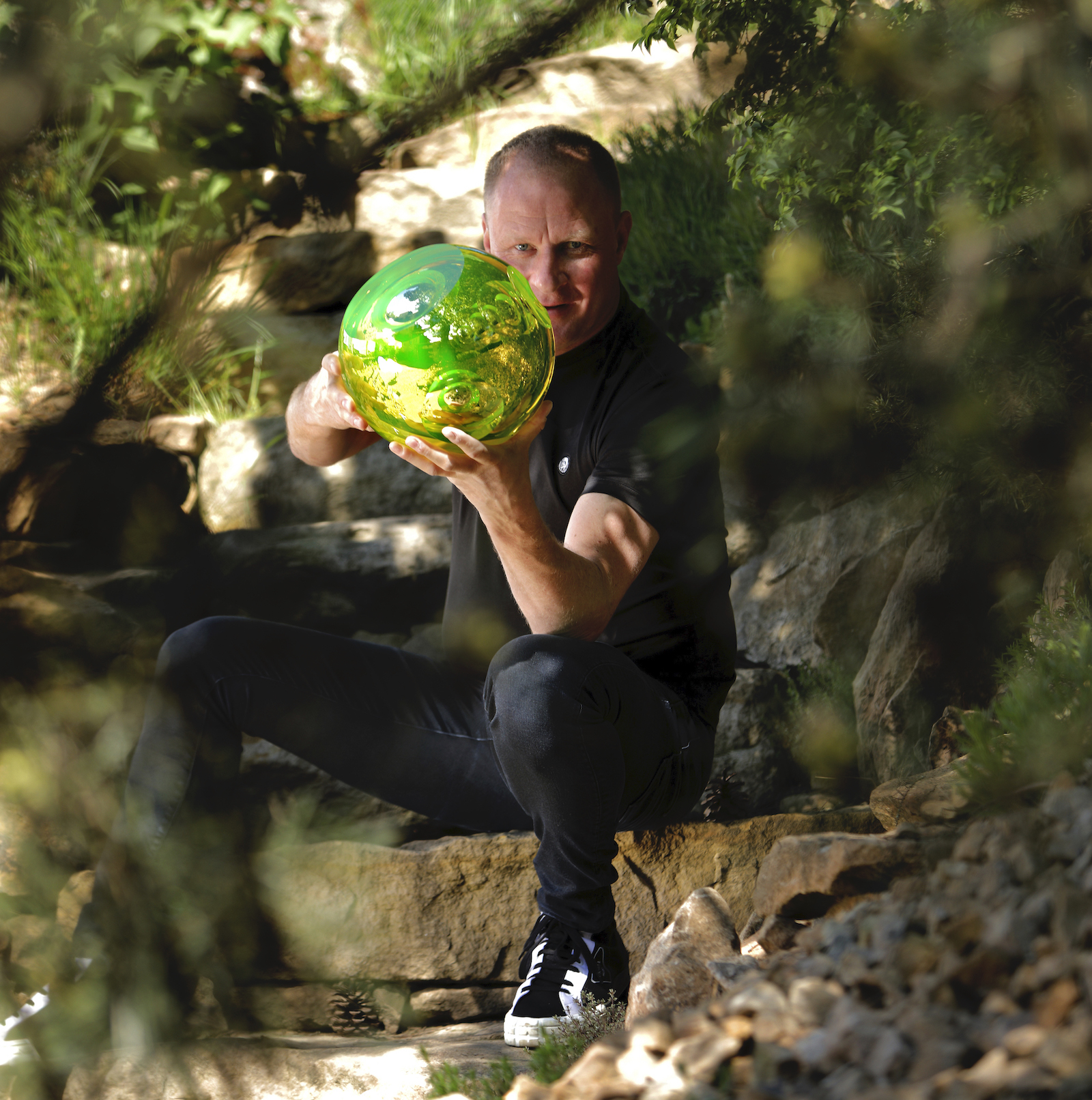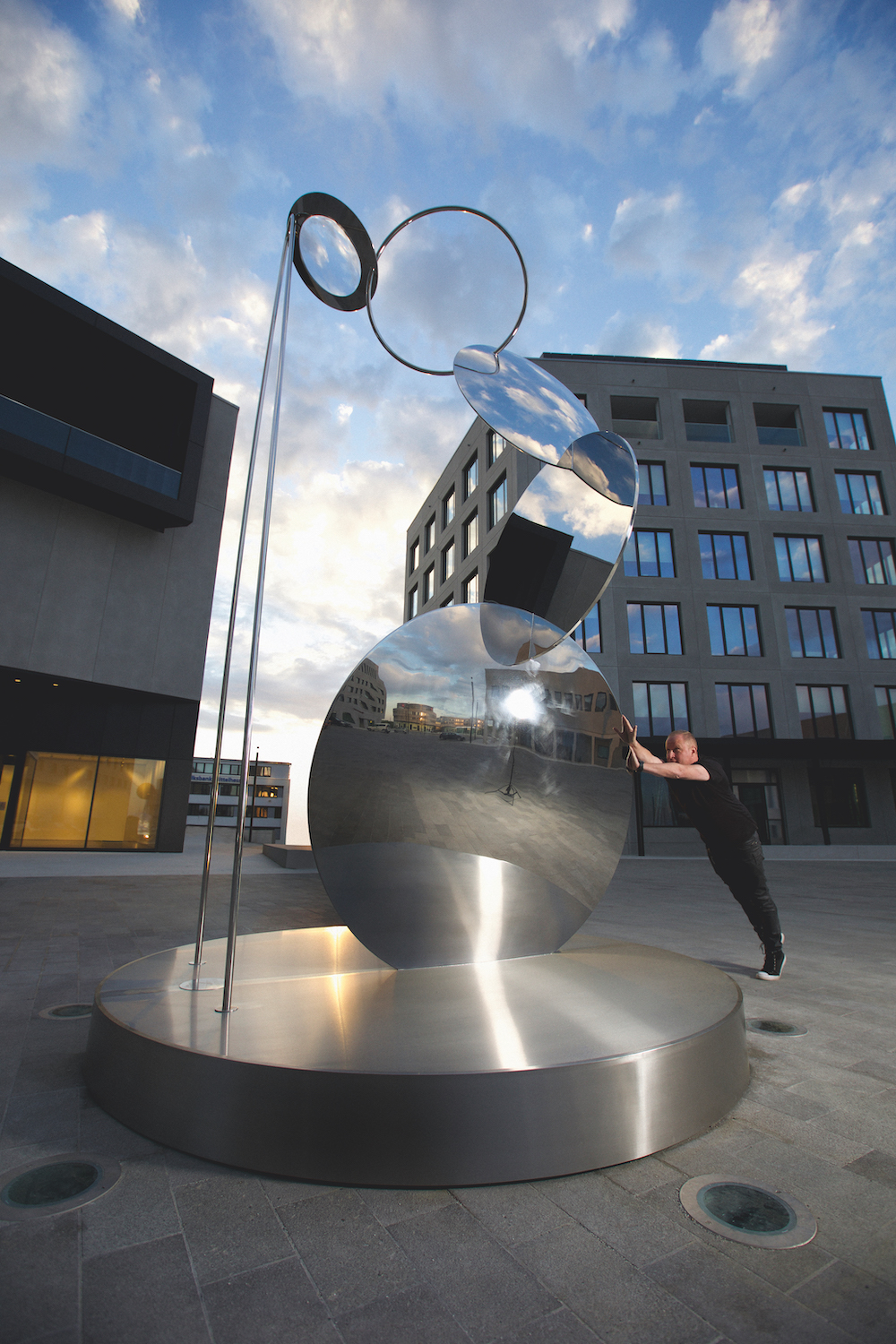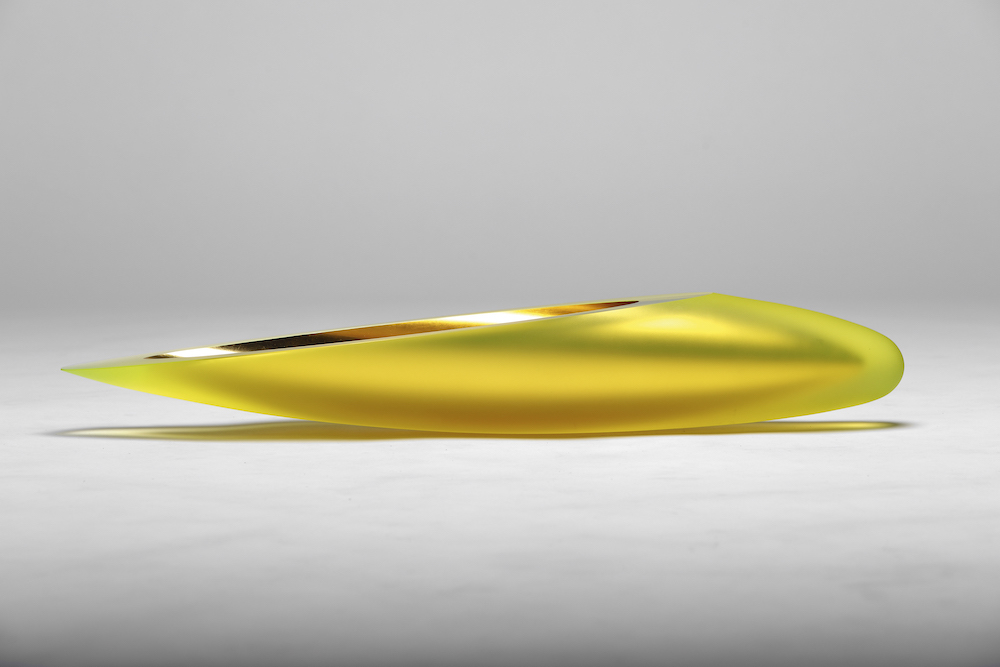“Art is supposed to spread beauty and positive energy, and make people happier”

Rudolf Burda, well-known artist
The interview with Rudolf Burda begins a new series by Czech and Slovak Leaders Magazine devoted to artists and entrepreneurs in the area of art, whom we want to at least support in this way during the current pandemic.
In accordance with the family tradition of Rudolf Burda IV., the artist Rudolf Burda claims that he is a harmonious and happy person at heart, and he reflects this positive attitude in his production. He’s rightly proud of his background, family and roots. He uses his grandfather’s logo from the year 1930. It’s a stylised linden leaf bearing the initials RB. During an informal interview, aimed at getting to know one another, he starts talking about his children; he’s the proud father of 17-year-old son Rudolf V. and 12-year-old daughter Karolína.
He characterises himself as an extrovert-introvert Gemini, and talks about his work and production with enthusiasm and zeal. As is often the case with true personalities, he’s modest by nature. You’ll find Rudolf Burda’s work in private collections and galleries worldwide, and in the palaces of Middle East monarchs and the Sultans of Malaysia and Oman, as well as in the Czech Republic. You might even have his latest object at home. He donated the SUN SHIP object, which was exhibited in February in Beverly Hills, to Gallery Kodl for a charity auction. It’s made from Czech uranium glass, refined by matting and a unique method in the interior, which is gilded with four layers of 24-carat gold leaf. Half of the auctioned amount will be donated to the Paraple Centre.
How to understand abstract art? How is Rudolf Burda producing art during the pandemic? How does he perceive Czech culture? And what is he looking forward to when the world returns to a new normal?
Your art is characterised by Leonardo da Vinci’s quote: “Simplicity is infinite perfection“.
Art is my reflection. If you observe my creations, whether they’re glass objects or stainless steel sculptures, meant for an interior or an exterior, they always reflect me. I’m a minimalist and therefore I create clean geometric forms, which I try to simplify even further in order to get to the marrow, the very essence of the object. I try to achieve birth itself, according to the example of the perfection of a hen’s egg. Nothing can be added to or removed from it; any change would be counterproductive. My art appeals to people across continents – I’ve exhibited it in Asia, America and Europe. The language of abstract art is comprehensible because it contains enchanted codes which are common for all nations. My greatest inspiration is the universe and nature. I connect the macrocosm and the microcosm. The works reflect the “original essence“, so the end collector can easily decipher them. It is the purity and harmony which engage the interest of art admirers.
Our interview will be published as part of a new cycle which focuses on supporting artists. How is the artist Rudolf Burda doing – and producing art – during the pandemic?
Things are much harder for artists at this time, but then again things are harder for every one of us on this planet, because globally everything has stopped, changed or turned upside down. I spent the last seven years travelling intensively to expositions around the world. My rhythm consisted of a week at home, then a week in the USA. A week at home, then two weeks in Asia. I felt like a global “art star“. It was certainly a good feeling for my ego, but in my heart I’m a boy from Jizera, just like my father and grandfather. I’m proud to be Rudolf Burda IV. I draw not only from my dreams, but also from nature and the Czech landscape, which I love.
I also draw inspiration from my stays abroad, where I notice both the exotic landscape and the modern architecture. Everything is a stimulus for me, which I process further. Expositions are suspended, and galleries are mostly closed or in an emergency regimen. So I’m enjoying my current stay at home, otherwise known as “house arrest“. Before the pandemic, I wished for space to rest and relax at home, to sketch things and concentrate on producing art. I dreamt of regular walks with my two beagles through the meadows along the Jizera river, where I can watch the horizon or the river’s flow, and think about how to imprint everything in my work. The wish was so intense that I sometimes have the feeling I may have set off the pandemic, so that it would come true in its entirety. Fortunately I don’t have to complain about a lack of work; even at this time, people are interested in my creations. Of course, this situation cannot last long, otherwise I would grow tired of it. But, for now, I welcome the peace I have to work and produce art. However, artists who must perform publicly, as well as their entire teams, are being badly damaged by this situation. The state should find funds which it can fairly, honestly and systematically distribute in order to support their further activity and existence.
You yourself repeatedly mentioned that you produce art when you’re happy and in harmony, because it is this state of mind that’s reflected in your work. How would you argue with the claims made by some high-ranking government officials, who promote the theory that the greatest works of art were created when the artists were hungry and in need?
I consider such statements to be misleading and untrue. I can’t look into any artist’s mind or heart regarding the impulses which they need for their work. If someone needs a large amount of alcohol to produce art, if they need to be divorced, have nothing to pay the bills and be in a permanent state of depression, taking walks along the Vltava river with the only thing on their mind being the question of whether to jump in or not, then that’s their choice. It’s the other way around for me. I find it easiest to produce art if I read a nice book in the evening, I’ve eaten well, I have my hair cut and I have sufficient funds to not feel under excessive pressure. Negative energy can derail me. When I have peace, harmony, happiness and a supportive environment, then I create clean works which radiate this pure cosmic energy. At least that’s what my clients write to me. My works are basically positive emitters. In my opinion, ideas about ragged artists belong to the last, or even second-to-last century.
Let’s now move on to the family tradition, and the question of continuity and change at the same time. You’re the proud Rudolf Burda IV., and you work with traditional glass, but at the same time your creations are very futuristic. How do these opposites relate to one another?
The connection with the family name is important; it’s an interesting story even for foreign gallerists. We already talked about my Gemini disjointedness, so on the one hand I respect traditions, follow on from the work of my ancestors, and build a family property and a terraced garden. Our ancestors’ work is simultaneously our future. I like nations which care for the past, and use it as a model for the future. I myself create objects from glass, which has a thousand-year-old tradition in our Czech meteorite crater. Glass-making involves birth and fire. I originally graduated from jewellery school as an artisan blacksmith, so I started off with fire and got to the glass- making kiln afterwards. There’s a tradition in glass-making, but I don’t want to be bound by it. I don’t like to keep to any established colours or ornaments. I don’t like ornaments, which is why I also don’t like being described as a glass artist or designer. I’m best described as an artist or a sculptor, because I also produce enamel paintings and stainless steel sculptures. By creating futuristic glass objects inspired by the universe, I’m moving classic Czech glass-making technology into the future. Another aspect of glass-making that I like is the teamwork. As many as seven people, each with their own role, might participate in the creation of one object. It’s a kind of harmonic concert, symbiosis, collaboration, sweat and hard work. Unity and togetherness lead to a beautiful result. Unless the work cracks, that is… in which case we start again.
You mentioned that you like nations that care for the past. How do we Czechs care for it?
A tendency often appears to spit on us Czechs, in the sense that we don’t care for history, that everything is incorrect and wrong. I’ve visited a lot of countries, and I think that we’re still doing well in the Czech Republic. Whether it concerns the economy, culture, healthcare or citizens’ overall education and erudition, we’re doing very well, despite criticism of the advent of social networks and the growth of disinformation. Those with an education and an overview will certainly be able to meet this challenge. Our nation takes very good care of monuments and cultural heritage, although there’s always room for improvement. Most monuments are repaired, and we have beautiful museums and theatres as well as a wide network of libraries. I have lots of restaurateurs, artisan blacksmiths and joiners among my friends. Czech artisan craftsmen are sought-after worldwide. My last work, SUN SHIP, which was donated to Gallery Kodl and which you mentioned in the introduction, uses unique gilding which I developed with one restaurateur. We were inspired by gilded Baroque sculptures, and after several years of trial and error we found a method by which gold will attain an inimitable gleam, and support the atmosphere of the work.

What are your plans for 2021?
As I already mentioned, during the pandemic I was very busy and I completed several long- term projects. I placed the work “Circle of Life“ in the entrance hall of the Klaudiánova Hospital in Mladá Boleslav. It’s a large stainless steel lens with a glass centre, symbolising the impact of a drop on water. After that I created several glass objects, and I’m also working on other projects which I’ll be able to present in the coming months. I’m starting to build a minimalist studio, which will be set in a terraced garden. I inherited an upholstery workshop from my grandfather, which I’ve been using as a studio, but it’s no longer suitable as a presentable space for respected and high-ranking foreign visitors, often from royal or monarchical families. I’m planning to start building in the spring of 2021. I’m looking forward to one large sculpture, made from polished stainless steel, becoming an adornment for one Czech city as the largest stainless steel stele in the Czech Republic. I’m designing several sculptures for private collections.
And where abroad are you planning to go, when it’s possible?
And we’re back to me being a Gemini. I love travel, just like I love being at home. First of all I’ll go and see my gallerist in Singapore, because I’m preparing a project with the former director of the Mori Art Museum in Tokyo, Mr. Nanjo, and my gallerist, Mr. Kasuga. In Europe, I’m looking forward to visiting my beloved Madrid. I like walking through the Royal Park, and I love jamón and cheese. I like the USA, especially Miami, where I exhibit my art at the Art Miami exposition. I also like Chicago – it’s a beautiful city with a gorgeous lake, an excellent astronomical observatory and a large Czech presence. I’m probably looking forward to New York the most. For me, New York represents concentrated energy, noise, skyscrapers and something different on every corner. The city pulses, and it’s home to not only gallerists and collectors but also my friends. Through my art, I’ve made lots of friends all over the world, so I can fly wherever I like and feel a bit at home everywhere.
We recently celebrated the anniversary of the 17th of November, which I personally perceive as being as important as the 28th of October, because I experienced it myself. To conclude the interview, what do you wish for the Czech Republic and the readers of Czech and Slovak Leaders Magazine?
For the republic, I wish that we, the people in it, like and respect one another. Respect, between both people and nations, is what’s most important. A lack of respect gives rise to conflict and wars. Let’s laugh a lot, because laughter is the best medicine and makes us happy. As for art, let’s not forget to devote ourselves to it. Let’s discover forgotten composers, reveal old canvasses and graphics, and appreciate the beauty of Czech churches, cobbled streets, towns and villages. While walking through nature, let’s notice forgotten churches in the Czech landscape, which we’ll find between fields. Let’s try to rejoice in every moment, because we don’t know what will happen in a year’s time. Let’s enjoy the present.
Follow Rudolf Burda:
By Linda Štucbartová


